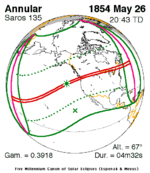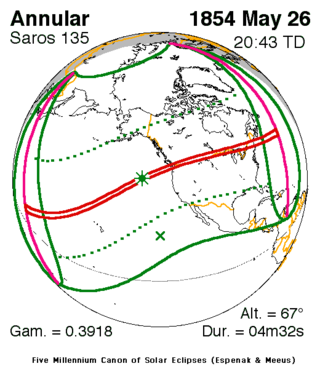Solar eclipse of May 26, 1854
| Solar eclipse of May 26, 1854 | |
|---|---|
| Type of eclipse | |
| Nature | Annular |
| Gamma | 0.3918 |
| Magnitude | 0.9551 |
| Maximum eclipse | |
| Duration | 272 s (4 min 32 s) |
| Coordinates | 43°18′N 140°06′W / 43.3°N 140.1°W |
| Max. width of band | 178 km (111 mi) |
| Times (UTC) | |
| Greatest eclipse | 20:42:53 |
| References | |
| Saros | 135 (30 of 71) |
| Catalog # (SE5000) | 9173 |
An annular solar eclipse occurred on May 26, 1854. A solar eclipse occurs when the Moon passes between Earth and the Sun, thereby totally or partly obscuring the image of the Sun for a viewer on Earth. An annular solar eclipse occurs when the Moon's apparent diameter is smaller than the Sun's, blocking most of the Sun's light and causing the Sun to look like an annulus (ring). An annular eclipse appears as a partial eclipse over a region of the Earth thousands of kilometres wide.
Visibility[edit]
The annular path crossed close to the boundary between the United States and Canada.
Observations[edit]
 Annularity Daguerrotyped by Stephen Alexander from Ogdensburgh, New York |
 Partiality by Langenheim Brothers. |
Related eclipses[edit]
It is a part of Solar Saros 135.
Solar eclipse set repeats every 6 synodic months (about 177.183 days).
| Solar eclipse series sets from 1852 to 1855 | ||||
|---|---|---|---|---|
| Ascending node | Descending node | |||
| 115 | June 17, 1852 Partial |
120 | December 11, 1852 Total | |
| 125 | June 6, 1853 Annular |
130 | November 30, 1853 Total | |
| 135 | May 26, 1854 Annular |
140 | November 20, 1854 Hybrid | |
| 145 | May 16, 1855 Partial |
150 | November 9, 1855 Partial | |
Saros 135[edit]
It is a part of Saros cycle 135, repeating every 18 years, 11 days, containing 71 events. The series started with partial solar eclipse on July 5, 1331. It contains annular eclipses from October 21, 1511, through February 24, 2305, hybrid eclipses on March 8, 2323, and March 18, 2341, and total eclipses from March 29, 2359, through May 22, 2449. The series ends at member 71 as a partial eclipse on August 17, 2593. The longest duration of totality will be 2 minutes, 27 seconds on May 12, 2431.
| Series members 33–43 occur between 1901 and 2100: | ||
|---|---|---|
| 30 | 31 | 32 |
 May 26, 1854 |
Jun 6, 1872 | Jun 17, 1890 |
| 33 | 34 | 35 |
 Jun 28, 1908 |
 Jul 9, 1926 |
 Jul 20, 1944 |
| 36 | 37 | 38 |
 Jul 31, 1962 |
 Aug 10, 1980 |
 Aug 22, 1998 |
| 39 | 40 | 41 |
 Sep 1, 2016 |
 Sep 12, 2034 |
 Sep 22, 2052 |
| 42 | 43 | |
 Oct 4, 2070 |
 Oct 14, 2088 | |
Notes[edit]
References[edit]
- Earth visibility chart and eclipse statistics Eclipse Predictions by Fred Espenak, NASA/GSFC
- Total Eclipses of the Sun, By Mabel Loomis Todd, 1894, new and revised edition by David P. Todd, 1900. [1]
- Suggestions relative to the observation of the solar eclipse of May 26, 1854, Astronomical Journal, vol. 3, iss. 70, p. 169–172 (1854). Alexander, S.
- On the solar eclipse of 1854, May 26, Bartlett, W. H. C. Astronomical Journal, vol. 4, iss. 77, p. 33–35 (1854).
- Observation of the annular eclipse of May 26, in the suburbs of Ogdensburgh, N. Y. Astronomical Journal, vol. 3, iss. 70, p. 169–172 (1854). Alexander, S.





